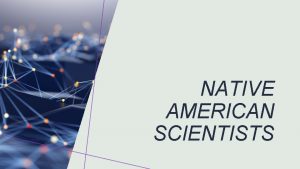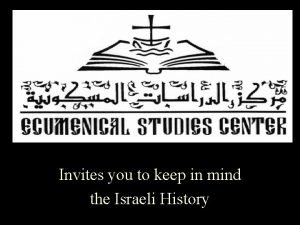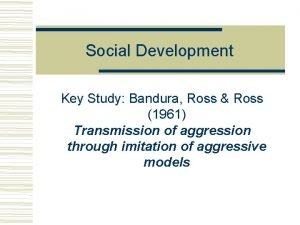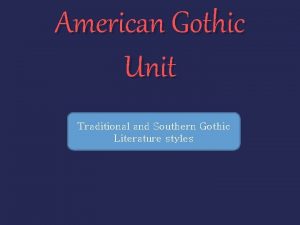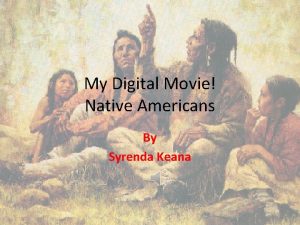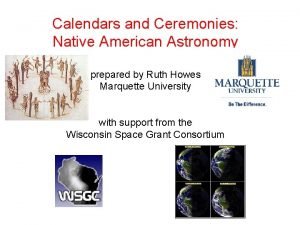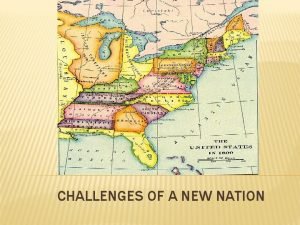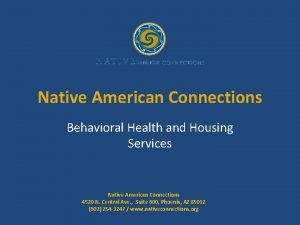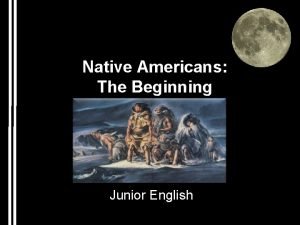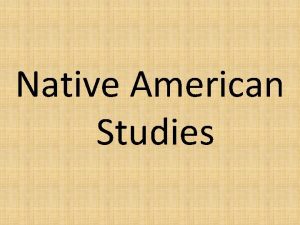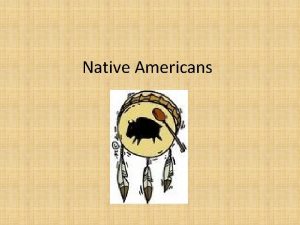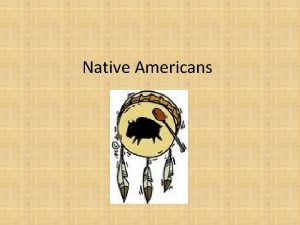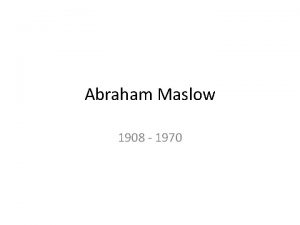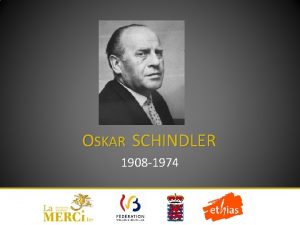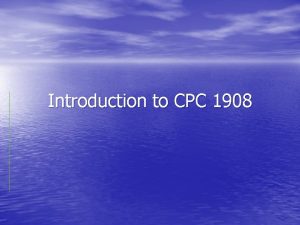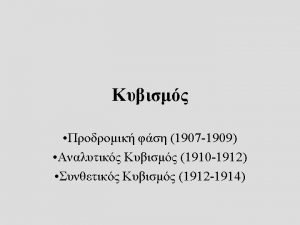NATIVE AMERICAN SCIENTISTS MARY GOLDA ROSS Ross 1908







![BERTHA PARKER Bertha Parker Pallan [Cody] (1907 -1978) is considered one of the first BERTHA PARKER Bertha Parker Pallan [Cody] (1907 -1978) is considered one of the first](https://slidetodoc.com/presentation_image_h2/817e4107c8225ace12b6f7685067c999/image-8.jpg)


- Slides: 10

NATIVE AMERICAN SCIENTISTS

MARY GOLDA ROSS Ross (1908 -2008) was a NASA mathematician and engineer who played a pivotal role in sending Apollo astronauts into space. For Lockheed Martin, she helped develop plans for the P-38 Lightning fighter plane and was one of just two women on the original Skunk Works team. Much of her work in the research, evaluation, and testing of top secret rocket and missile systems is still classified. Ross also helped write NASA’s Planetary Flight Handbook, the agency’s guide to space travel. •

JOHN HERRINGTON Herrington (1958 - ) was the first Native American to go to and walk in space and was part of the 16 th shuttle mission to the International Space Station in 2002. To commemorate his heritage, he carried six eagle feathers, a braid of sweet grass, two arrowheads, and the Chickasaw Nation’s flag, according to the American Indian Education Fund. •

SUSAN LA FLESCHE PICOTTE Le Flesche Picotte (1865 -1915) was the first Native American to earn a medical degree. She studied at the Women’s Medical College of Pennsylvania in Philadelphia, and graduated first in her class in 1889. She soon returned to the Omaha Reservation, where she went on to treat thousands of people. She's credited with building the first private hospital on a Native American reservation. •

AARON YAZZIE Yazzie (1986 - ) is a mechanical engineer who works at NASA's Jet Propulsion Laboratory in Pasadena, California. He has developed mechanical systems that help analyze Mars' atmosphere and Martian soil samples. His technology is currently at work on the Mars Insight Lander, and he is working on the Mars 2020 mission, which will launch next July. Follow him on Twitter to keep up with the mission. •

XIYE BASTIDA Bastida (2002 -) is a youth climate activist from a small town just outside Mexico City. She has worked to bring awareness to Native perspectives and keep Native voices at the forefront of the climate movement. Inspired by Greta Thunberg, Bastida has joined the Fridays for Future initiative and protests each Friday in front of the United Nations Building in New York. • https: //www. popularmechanics. com/science/g 29460020/ indigenous-scientists/? slide=6 •

NANIBAA' GARRISON Nanibaa’ Garrison (Navajo), Ph. D. is an Associate Professor at the University of California, Los Angeles. She has appointments in the Institute for Society and Genetics, the Institute for Precision Health, and the Division of General Internal Medicine & Health Services Research. She is a teaching faculty for the UCLA genetic counseling master’s program. • Dr. Garrison earned her Ph. D. in genetics at Stanford University, and completed a postdoctoral fellowship in bioethics at the Stanford Center for Biomedical Ethics and the Center for Integration of Research on Genetics & Ethics at Stanford University. Prior to coming to UCLA, Dr. Garrison was an Assistant Professor at Vanderbilt University, University of Washington and Seattle Children’s Research Institute. • Dr. Garrison is the recipient of an NIH K 01 career development award to explore perspectives of tribal leaders, physicians, scientists, and policy makers on genetic research with tribes. Her research focuses on the ethical, social, and cultural implications of genetic and genomic research in Indigenous communities. Using community-based research approaches, she engages with tribal communities to develop •
![BERTHA PARKER Bertha Parker Pallan Cody 1907 1978 is considered one of the first BERTHA PARKER Bertha Parker Pallan [Cody] (1907 -1978) is considered one of the first](https://slidetodoc.com/presentation_image_h2/817e4107c8225ace12b6f7685067c999/image-8.jpg)
BERTHA PARKER Bertha Parker Pallan [Cody] (1907 -1978) is considered one of the first female Native American archaeologists. The caption to this photograph said that Bertha Pallan was an "expedition secretary" who was demonstrating "the difference in size of early type [small] and large type atlatl darts from Gypsum Cave. " This photograph may be related to an expedition sponsored by the Southwest Museum (Los Angeles). In 1936, Bertha married Iron Eyes Cody (1904 -1999). In the 1950 s, they hosted a television program explaining Indian history and folklore and served as technical advisers on several films. •

SCOTTIE HENDERSON Henderson was born in 1968 and grew up in Española, New Mexico, a town filled with Pueblo Indians, Hispanics, and Anglos. Despite Española being a diverse town, Henderson noticed that Native Americans were always treated a little differently. She said they weren’t expected to do as much because we were Indian, and as a result, many Indians in the area didn’t finish school. Henderson began to see herself in the same way. • When her parents realized this, her mother encouraged her to attend Northern New Mexico Community College. Her father was also instrumental in her education. He works at Los Alamos National Labs, which has a program that helps the children of employees to go to a University of California school. • Hernderson then pursued a life-long interest in the sciences and chose to study marine biology at the University of California, Santa Cruz (UCSC) where she graduated with a B. S. degree in 1992. She later attended University of Washington for graduate school. •

FRED BEGAY Fred Begay was born in 1932 on the Ute Mountain Indian Reservation in Colorado. His parents, who were Navajo and Ute healers and spiritual leaders (Hataaliis), taught him traditional Navajo ceremonies. “It turns out many of the prayers and songs have built in lots of science, ”says Begay. “I was immersed in all that knowledge before I even got to the first grade. ” Begay was sent to a federal boarding school for American Indians and was discouraged from practicing his religion and using his language. His parents didn't know english and couldn't tell the school what they wanted him to learn, so he was taught farming. • In 1951, after eight years learning to be a farmer, Begay joined the U. S. Air Force and fought in the Korean War. When he returned, with funding from the Department of Veterans Affairs, Begay enrolled at the University of New Mexico in 1955. To make up for his lack of a standard pre-college education, Begay had to take high school classes in the evenings while attending college courses during the day. • Not having attended high school, Begay was unfamiliar with academic subjects. “I had no knowledge of physics, or math, or English, or any of that, ” he says. So his decision to study physics was “just an accident, ” he says. • He continued to pursue the subject, and after receiving a Ph. D in nuclear physics from the University of New Mexico in 1972, he joined the research staff of Los Alamos National Laboratory. • Much of Begay’s research has focused on controlled thermonuclear fusion. Fusion in plasmas- hot ionized gases- could potentially provide a clean, practically unlimited energy source as an alternative to fossil fuels. But plasma physicists have been trying unsuccessfully for decades to build a reactor that puts out more energy than it takes in. Begay has recently been investigating a phenomenon called “soliton turbulence, ” that he believes might cause instabilities in the plasmas, making them useless for fusion. He hopes his research will help point to ways to avoid these problems. • Though he didn’t receive a standard high school education, Begay believes that in some ways the Navajo culture helped prepare him to study science. “I think the key point is that I •
